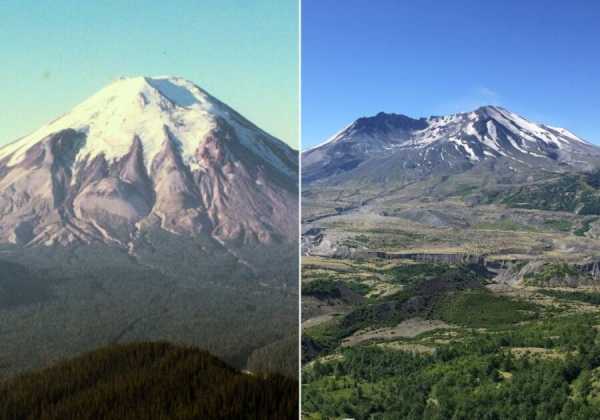When Mount St. Helens erupted on May 18, 1980, the devastating explosion killed 57 people, destroyed a forest the size of Chicago, and altered Washington’s landscape forever.





Wikimedia CommonsOne of the eerie final photos of the Mount St. Helens eruption taken by photographer Robert Landsburg, one of the 57 people who died.
Mount St. Helens after the eruption was never the same again.
The Volcano After The Eruption
The eruption of Mount St. Helens destroyed 230 square miles of forests and obliterated all trees within six miles. It killed 57 people, some 7,000 big game animals, and 12 million young salmon, as well as almost all the birds and small mammals in its path. The United States Geological Survey additionally reports that the eruption also destroyed 27 bridges, 185 miles of highways and roads, 15 miles of railways, and more than 200 homes.
Spirit Lake was also buried beneath tons of ash, tree debris, and mud.
In the days afterward, the area around Mount St. Helens looked like another planet. Everything was gray and draped in ash. Flat, colorless earth stood where forests had once thrived, and the air was still and quiet without birdsong.

U.S. Forest ServiceThe same plot of land near Mount St. Helens in 1979 (left) and 1981 (right).
“The initial impression was that nothing or few things would survive,” Charlie Crisafulli, an ecologist with the U.S. Forest Service Pacific Northwest Research Station and one of the first scientists to arrive on the scene after the eruption, recounted to CBS News in 2015. “It looked like everything had been destroyed, that all vestiges of life had been snuffed out.”
But despite the unfathomable destruction of the eruption, life on the mountain slowly crept back. Ants and gophers — which had survived by burrowing underground — began to emerge, and vibrant flowers like the purple-blue prairie lupines began to sprout. Robins, attracted by the open space, flocked to the region, and elks began to return to take advantage of the new plant life.

United States Geological SurveyAvalanche lilies on Mount St. Helens in June 1980, just a month after the volcanic eruption.
Meanwhile, the landscape around Mount St. Helens changed in other ways as well. The eruption had created 150 new lakes and ponds, according to the U.S. Department of Agriculture, and Spirit Lake slowly came back to life. Wider, shallower, and warmer than before, it now fosters different kinds of species, like rainbow trout. Dead trees, which float in the lake to this day, also created a “floating ecosystem” for new insects.
Though some species have not returned to the area — like flying squirrels — researchers have been overall impressed with the resilience of the Mount St. Helens ecosystem. And because Congress allocated 110,000 acres of wildlife around the mountain for the National Volcanic Monument, nature there has been allowed to thrive unmolested.
That is, until the next time Mount St. Helens erupts.
After learning the story of Mount St. Helens before and after the eruption, learn about the worst volcanic eruptions in history. Then, see the chilling bodies of Pompeii left behind after the eruption of Mount Vesuvius.
Sourse: www.allthatsinteresting.com





